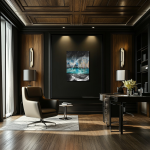Ethereal Tides: The Museum at Le Havre Reimagined
This surreal reinterpretation of Claude Monet’s The Museum at Le Havre (1873) transforms the harbor into an ethereal dreamscape, softly dissolving architecture, boats, and reflections into fluid veils of translucent color and light. The museum emerges ghostlike within misty layers, symbolizing the delicate intersection of memory, reality, and imagination. Ships drift gently through luminous waters, symbolizing humanity’s intangible quest for meaning. This piece poetically explores the fragile balance between permanence and transience, inviting contemplation of perception’s gentle, endless tides.
Please see Below for Details…
Hotline Order:
Mon - Fri: 07AM - 06PM
404-872-4663
Claude Monet’s The Museum at Le Havre (1873) goes beyond merely portraying a picturesque view of a museum along a bustling harbor; it encapsulates the essence of a transient world where life moves in fluid harmony. Monet's original work presented the vibrant interplay of water and architecture through delicate brushstrokes, capturing the nuances of reflections, sails, and the shifting moods of the harbor. In his vision, the buildings were sturdy yet softened, becoming more than architectural forms—they became poetic symbols of human endeavor and creativity reflected upon the restless water.
This surreal reinterpretation amplifies Monet's nuanced vision, weaving a profound dreamscape where reality is gently submerged beneath an ethereal veil. Here, the harbor is no longer simply a place of docking ships and bustling life—it is transformed into an intangible realm where water and air merge seamlessly, dissolving the boundaries of architecture, ocean, and human presence into a single unified experience. The familiar façade of the museum emerges mysteriously through layers of softly undulating veils of translucent light, appearing both solid and ephemeral at once.
At the core of the composition lies the museum structure, rendered in delicate shades of blues, creams, and whispering greys. Its outlines seem gently blurred, reminiscent of Monet’s original approach to capturing the impermanence of perception. The classical columns and detailed arches float serenely within the misty layers of the composition, becoming almost ghostly in their ethereal delicacy. The museum no longer stands as a mere monument to culture but is transformed into a symbolic gateway suspended within a timeless, watery space—existing somewhere between memory, imagination, and reality.
Around the museum, ships and sails appear softened, their sharpness diminished, transformed into fluid shapes drifting gently into one another. The sails, once symbols of human journey and adventure, now resemble delicate whispers of cloth floating softly on a breeze, becoming dreamlike fragments of an endless voyage. The traditional solidity of boats fades away as they hover gently above and within the harbor waters, symbolizing humanity’s eternal yet intangible quest for discovery, understanding, and connection with the world around them.
The water itself pulses with quiet luminescence, alive with a spectral glow that shimmers softly beneath the layers of surreal translucency. Monet’s original reflections, already richly textured, have here become a dance of elusive light and shadow, endlessly transforming the harbor into a meditative vision. The ripples and waves glide rhythmically, echoing the movement of a delicate unseen force, pulling the viewer deeper into contemplation, where solid form yields to poetic abstraction.
This surreal scene is further enriched by subtle, enigmatic shapes drifting gracefully throughout the space—fragments that evoke the softness of silk veils or whispers of mist gently cascading over the water's surface. These fluid shapes softly caress and envelop the museum and ships, creating a sense of intimacy and tenderness. They symbolize the ethereal veil between past and present, between reality and dreams, blurring the boundaries of perception and inviting viewers to step beyond tangible experience into an inner emotional realm.
The colors chosen for this reinterpretation reflect Monet’s fascination with subtlety and nuance. Deep aquamarines blend effortlessly with silvery blues and muted greys, capturing the very essence of a dream state. Soft reflections of warmer shades such as pale gold and blush pink occasionally shimmer, gently hinting at distant sunlit horizons or forgotten memories. These delicate colors are reminiscent of the twilight hours, a liminal time when reality gently melts into fantasy, and the ordinary becomes extraordinary.
In creating this artwork, my aim was to reflect Monet’s deep commitment to depicting transient beauty—transforming the physical museum at Le Havre into an emotional and poetic vision. This surreal reimagining challenges viewers to reconsider the nature of permanence, highlighting how memory, time, and perception are eternally intertwined. Here, the museum and harbor represent the ceaseless human quest for meaning amidst a fluid, impermanent existence, embodying the delicate balance between what we see and how we feel.
This composition serves as a contemplative reflection on the nature of perception itself, exploring the intersection between the material and the intangible. It invites viewers to surrender to the moment, to lose themselves in the ethereal tides of memory and emotion, and to recognize beauty not as a fixed entity but as a fleeting, ever-evolving experience. It gently suggests that reality itself can be dreamlike, endlessly shifting before our eyes, continually dissolving and reforming in response to our perceptions.
Ultimately, this surreal reinterpretation celebrates Monet’s vision by immersing viewers within a poetic space where architecture, water, and human presence merge seamlessly, existing delicately between reality and imagination. It serves as a gentle reminder that even within impermanence and uncertainty, beauty persists—quiet, elusive, and endlessly inviting us to look deeper, feel more profoundly, and dream beyond the visible.
Add your review
Your email address will not be published. Required fields are marked *
Please login to write review!
Looks like there are no reviews yet.








